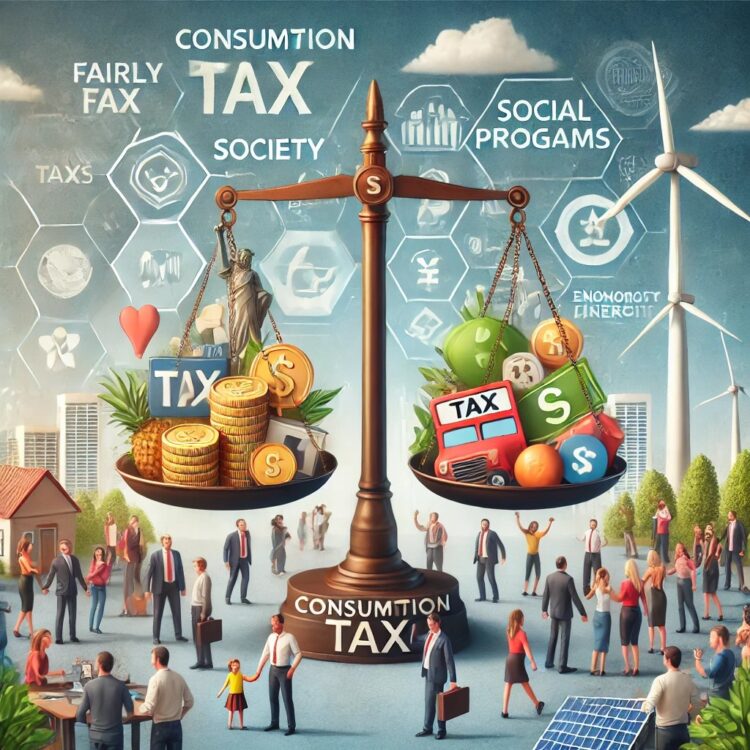
By Michael J. Tyler
The notion of a consumption tax, often met with scepticism due to its perceived regressive nature, can in fact be a transformative instrument in reducing poverty and fostering economic equity. A well-designed consumption tax not only shifts the tax burden more fairly across income groups but also encourages savings and investment, which benefits the poorest members of society in the long term. To understand its potential, it is crucial to examine how this tax structure can be implemented to provide equitable outcomes while stimulating economic growth.
A Shift Towards Equity
At its core, a consumption tax is levied on goods and services rather than income. Critics argue that such a tax disproportionately affects low-income individuals who spend a larger percentage of their income on consumption. However, this regressive impact can be mitigated through strategic policy design. Exempting or zero-rating essential goods such as basic food items, healthcare, and education ensures that the poorest are not disproportionately burdened. Similarly, implementing rebates, tax credits, or direct transfers to low-income households can offset their tax expenditures, effectively creating a progressive system.
Case studies from Australia highlight how such exemptions can work effectively. For example, the Goods and Services Tax (GST) introduced in 2000 excluded essential items such as fresh food, health, and education. This approach ensured that low-income households were not unduly burdened while maintaining the integrity of the tax system. Additionally, the Low Income Tax Offset (LITO) further helped to ease the burden on the most vulnerable.
Unlike income taxes, which often penalise those who strive to earn more, a consumption tax allows individuals to exercise greater control over their tax liabilities. For low-income earners, this means they can choose to save more, which is particularly impactful when paired with policies that encourage savings and provide financial literacy education. By incentivising saving rather than consumption, these taxes help create a pathway for wealth accumulation among the poorest members of society.
Stimulating Economic Growth
Consumption taxes have the potential to invigorate economic growth, which indirectly benefits the poorest segments of society. By shifting the tax base from income to consumption, governments can create a more efficient tax system that incentivises productivity and investment. This efficiency translates into increased job opportunities and higher wages over time, helping to lift individuals out of poverty.
The New Zealand GST model provides a case in point. Since its implementation, New Zealand has enjoyed robust economic growth, with the GST contributing to stable government revenue. By applying a uniform rate and broadening the tax base, the system has created room for increased government spending on public infrastructure and services, benefiting low-income communities.
Moreover, consumption taxes are less susceptible to evasion than income taxes, particularly among high earners with access to sophisticated tax planning strategies. A broader and more reliable tax base ensures consistent government revenue, which can be directed towards social programs, infrastructure, and public services that disproportionately benefit low-income communities.
Environmental and Social Benefits
Consumption taxes can also be designed to address broader social and environmental issues, creating further benefits for the poorest members of society. For instance, taxing luxury goods and environmentally harmful products at higher rates can generate revenue for climate change initiatives, healthcare, and education programs. These initiatives often have the greatest impact on low-income populations, who are most vulnerable to environmental degradation and lack access to quality public services.
A case study from Sweden illustrates this principle. Sweden imposes higher taxes on carbon-intensive goods while providing subsidies for renewable energy initiatives. This dual approach not only combats climate change but also funds public programs aimed at reducing inequality, showing how consumption taxes can align with broader social goals.
The Case for Pragmatism
Transitioning to a consumption tax-based system requires careful planning and pragmatism. Policymakers must ensure that the tax system remains transparent, easy to administer, and resistant to manipulation. Public education campaigns are essential to build trust and help individuals understand how the system benefits them.
Furthermore, a phased implementation approach allows governments to monitor and adjust policies to address unforeseen inequities. For example, rebates or cash transfers can be fine-tuned to ensure they reach the most vulnerable populations. Collaborating with community organisations and leveraging technology can help identify and address gaps in coverage.
Conclusion
A consumption tax, when designed with equity and efficiency in mind, has the potential to alleviate poverty and promote long-term economic stability. By exempting essential goods, providing targeted rebates, and leveraging the resulting revenue for social programs, governments can create a progressive tax system that empowers the poorest members of society. Far from being a regressive burden, a well-structured consumption tax is a tool for fostering economic inclusion and shared prosperity.